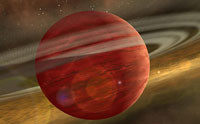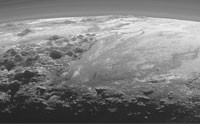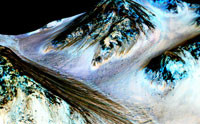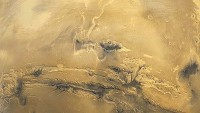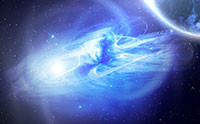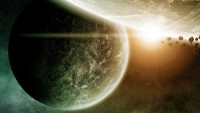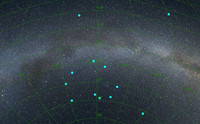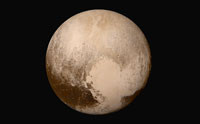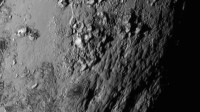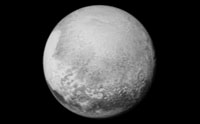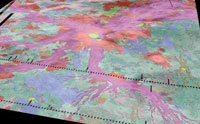By Dr. Andrew A. Snelling This contribution is designed to document the radioisotope dating data for groups of chondrites, stony achondrites, pallasites and mesosiderites, and irons. …read more Read more here: AIG Daily
The discovery of planets around distant stars isn’t new. Roughly 2,000 exoplanets are confirmed to exist. But astronomers claim to have direct evidence that a giant planet is in the process of forming. How strong is this claim? More… …read more Read more here: icr.org
Could an anomaly found in the map of the cosmic microwave background be from one universe bumping up against another? …read more Read more here: creation.com
Earlier this year, New Horizons flew past dwarf planet Pluto and its sister Charon, rapidly capturing data. That information continues to trickle in, revealing a surprisingly smooth heart-shaped plain called “Tombaugh Regio.” The countless craters expected from billions of years’ worth of impacts are nowhere to be found. More… …read more Read more here: icr.org
The European Space Agency’s Rosetta probe travelled all the way to comet 67P/Churyumov-Gerasimenko to collect unprecedented cometary details. The space probe keeps sending unexpected particulars about the comet—particulars with implications far beyond the comet itself. More… …read more Read more here: icr.org
Sneak peek of latest Creation magazine. As scientists digest information from Pluto, it’s obvious the planet is young and defies long-age expectations. …read more Read more here: creation.com
New methods using increased precision have allowed mankind to answer a fundamental question: Do other stars have planets? Natural philosophers have pondered this question for centuries. Johannes Kepler imagined beings on other planets in his book, The Dream, considered the first work of science fiction. Today’s scientists are finally able to move from fiction to fact. The answer is: Yes! Other stars do have planets. A follow-up question for creationists (and evolutionists) is: what does it mean for our worldview? Read More: Exoplanets – creation.com
Researchers in the field of astronomy have recently announced what is described to be a ‘truly monstrous’ structure, consisting of a ring of galaxies around 5 billion light-years across. Reported findings show that the seemingly unprecedented galactic ring, which was revealed by nine Gamma-Ray Bursts (GRBs), is located 7 billion light-years away. GRBs are thought to be the result of massive stars collapsing into black holes, ostensibly at the end of the stars’ lives. Because black holes are typically found inside galaxies, astronomers say the ring of GRBs is evidence of a gigantic galaxy ring. Beacons can be used to [More]
Scientists have announced indirect evidence of liquid water on the surface of Mars, raising hopes among secular scientists that life may be present on the “red planet.” But why do they hope for this—and are such hopes realistic? More… …read more Read more here: icr.org
Along with fudge factors, such as Dark Matter used to explain the big bang, the chameleon particle has been introduced even though there’s no evidence it exists. …read more Read more here: creation.com
By Dr. Danny Faulkner While water is a common substance in the universe, the earth is the only place that we know for certain where liquid water exists. …read more Read more here: AIG Daily
How did our solar system get here? Those who dismiss any possibility of creation imagine ways that pure natural forces might set in motion the sun, each unique planet and their moons. New computer modeling results seem to show promise—but only when they overlook or assume obvious and important factors. More… …read more Read more here: icr.org
By Dr. Danny Faulkner We here at Answers in Genesis believe that life is unique to Earth, so is the discovery of Kepler-452b a problem for us? …read more Read more here: AIG Daily
Progressive creationist Hugh Ross has declared as fact something about the alleged big bang that even evolutionists want to be true but have not claimed. …read more Read more here: creation.com
Despite claims that stars formed from primordial clouds of gas, the known laws of physics show that to be impossible. …read more Read more here: creation.com
By Dr. Danny Faulkner The asymmetry between matter and antimatter is not a problem if God created the universe as Genesis 1 says that He did. …read more Read more here: AIG Daily
A team of astronomers from Hungary and the United States, led by Professor Lajos Balázs of Konkoly Observatory in Budapest, has announced the discovery of an enormous ring of galaxies. According to the Big Bang model, this ring should not exist. More… …read more Read more here: icr.org
Astronomers have discovered what appears to be the largest feature in the observable universe, and—according to the Big Bang model—it shouldn’t even exist. A team of Hungarian and U.S. astronomers say they have discovered a huge ring of nine gamma ray bursts (GRBs) that is five billion light years across. The scientists detailed their findings in “Monthly Notices of the Royal Astronomical Society.” GRBs are thought to be the result of massive stars collapsing into black holes. Because black holes are typically found inside galaxies, astronomers say the ring of GRBs is evidence of a gigantic galaxy ring. All nine [More]
A darkness clouds the thinking of physicists, from dark matter to dark energy, dark fluid, dark flow, dark radiation and-now-dark photons. …read more Read more here: creation.com
The discovery of Earth 2.0 has evoked a speculative frenzy about it being habitable but does reality match the rhetoric? …read more Read more here: creation.com
Congratulations to the New Horizons team on their remarkable achievement of sending a spacecraft to Pluto. The mission was a complete success, and we are enjoying high-resolution images of never-before-seen surface features of this distant little world. These pictures dazzle the mind and are already beginning to challenge secular thinking. More… …read more Read more here: icr.org
By Dr. Danny Faulkner What recent photos of Pluto revealed was a shock to conventional uniformitarian scientists who believe in a 4.5-billion-year-old solar system. …read more Read more here: AIG Daily
Today, more than nine years after its launch, the New Horizons spacecraft is scheduled to make its closest approach to the dwarf planet Pluto. This will make New Horizons the first space probe to examine Pluto and its moons up close during this historic flyby. A NASA press release states, “A close-up look at these worlds from a spacecraft promises to tell an incredible story about the origins and outskirts of our solar system.” But what is the real story? More… …read more Read more here: icr.org
The tortured surface of Venus appears to have been formed through recent geologic processes, and its rocks contain no record of deep time. What if Venus were young rather than 4.5 billion years old? It would explain quite a bit, including a brand-new discovery made by scientists peering through its dense atmosphere. More… …read more Read more here: icr.org
Stars have an amazing variety, and pose problems for evolutionary views of their origin. …read more Read more here: creation.com
If theistic evolution is true, is God responsible for the universe? …read more Read more here: creation.com
Computer modelling that has led to dire warnings about climate change is built on questionable understanding of cloud behaviour. …read more Read more here: creation.com



















